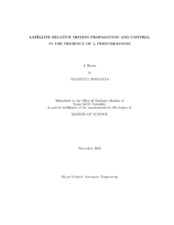| dc.description.abstract | Formation flying is a new satellite mission concept that is concerned with clusters of satellites in neighboring orbits cooperating to perform a specific task. The tasks may be Earth observation or space-based interferometry where a cluster of small satellites is able to fulfill the same requirements as that of a larger, monolithic satellite.
There exist a variety of models for the study of relative motion between two satellites. These include models based upon differential orbital elements, and relative position and velocity coordinates. Extensive work has been done on such models, both in the absence and presence of the J2 perturbation arising from the aspherical nature of the Earth, which causes variations in the orbital elements that describe the orbit. The approximate relative motion can be obtained analytically by using mean elements. However, the true orbit can only be described by the instantaneous osculating elements.
An analytical method to propagate the relative motion between two satellites in highly elliptic orbits is the main focus of this thesis. The method is kinematically exact and it maintains a high degree of accuracy even in the presence of J2 perturbations. Mean orbital elements are used for orbit propagation, and expansions involving the powers of eccentricity are not utilized. The true anomaly of the reference satellite is treated as the independent variable, instead of time. The relative orbit kinematics are obtained by using a projection onto a unit sphere. This procedure allows the relative position variables to be treated as angles depending on the orbital element differences. The effect of adding short-period corrections due to J2 to the mean elements is also studied.
Finally, the problem of formation reconfiguration is studied. The reconfiguration of a formation may be achieved by using impulsive thrust (velocity increments) or continuous control. This thesis presents a method to obtain the optimal velocity increments through numerical optimization, utilizing the analytical technique developed for relative orbit propagation. A continuous control law is also developed using a candidate Lyapunov function, and the asymptotic stability of the closed-loop system is ascertained. | en |


